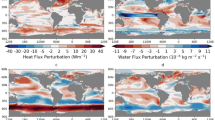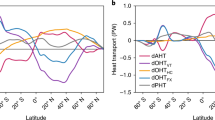Abstract.
The potential effects of a dynamic ocean on climate change are assessed by comparison of a simulation from 1880 into the future by the CSIRO (Mark 2) coupled atmosphere–ocean general circulation model with equilibrium results from a mixed-layer ocean (MLO) version of the model. At 2082, when the effective CO2 is tripled, the global warming in the coupled model is barely half the 3×CO2 MLO result, largely because of oceanic heat uptake, as diagnosed using an effective heat capacity. The effective ocean depth continues to increase during a further 1700 years with stabilized tripled CO2, by which time the mean ocean warming reaches the upper ocean value. Some reduction of the coupled model warming is due to the effective sensitivity (for 2×CO2), determined from the radiative response to the forcing, being persistently 0.2 K lower than the MLO model value. A regional energy and feedback analysis shows that this is largely due to an overall equatorward oceanic heat transport anomaly, which reduces the high-latitude warming in the coupled model. The global warming at 3800 is around 95% of the anticipated equilibrium value, which is matched by the result of a simple energy balance model for the approach to equilibrium. The geographical effect of the oceanic heat transport is confirmed using a mixed-layer model with perturbed oceanic heat convergence. The eastern equatorial Pacific warming is enhanced by over 1 K, and rainfall is perturbed in an ENSO-like pattern.










Similar content being viewed by others
References
Bi D (2001) Dependence of the oceanic response to global warming on the basic state of the ocean. PhD Thesis, University of Tasmania, Hobart, Australia
Cai W, Whetton PH (2001) A time-varying greenhouse warming pattern and the tropical-extratropical circulation linkage in the Pacific Ocean. J Clim 14: 3337–3355
Cubasch U, Meehl GA, Boer GJ, Stouffer RJ, Dix M, Noda A, Senior CA, Raper S, Yap KS (2001) Projections of future climate change. In: Houghton JT, Ding Y, Griggs DJ, Noguer M, van der Linden PJ, Dai X, Maskell K, Johnson CA (eds) Climate Change 2001: The scientific basis. Cambridge University Press, Cambridge, UK, pp 525–582
Hirst AC (1999) The Southern Ocean response to global warming in the CSIRO coupled ocean–atmosphere model. Environ Model Softw 14: 227–241
Leggett J, Pepper WJ, Swart RJ (1992) Emission scenarios for the IPCC: an update. In: Houghton JT, Callander BA, Varney SK (eds) Climate Change 1992. The supplementary report to the IPCC Scientific Assessment, Cambridge University Press, Cambridge, UK, pp 69–95
Murphy JM (1995) Transient response of the Hadley Centre coupled ocean–atmosphere model to increasing carbon dioxide. Part III: analysis of global-mean response using simple models. J Clim 8: 496–514
Raper SCB, Gregory JM, Osborn TJ (2001) Use of an upwelling-diffusion energy balance model to simulate and diagnose AOGCM results. Clim Dyn 17: 601–613
Raper SCB, Gregory JM, Stouffer RJ (2002) The role of climate sensitivity and ocean heat uptake in AOGCM transient temperature response. J Clim 15: 124–130
Senior CA, Mitchell JFB (2000) The time dependence of climate sensitivity. Geophys Res Lett 27: 2685–2688
Stouffer RJ, Manabe S (1999) Response of a coupled ocean–atmosphere model to increasing atmospheric carbon dioxide: sensitivity to the rate of increase. J Clim 12: 2224–2237
Voss R, Mikolajewicz U (2001) Long-term climate changes due to increased CO2 concentration in the coupled atmosphere–ocean general circulation model ECHAM3/LSG. Clim Dyn 17: 45–60
Watterson IG (2000) Interpretation of simulated global warming using a simple model. J Clim 13: 202–215
Watterson IG, Dix MR (1996) Influences on surface energy fluxes in simulated present and doubled CO2 climates. Clim Dyn 12: 359–370
Watterson IG, O'Farrell SP, Dix MR (1997) Energy and water transport in climates simulated by a general circulation model that includes dynamic sea ice. J Geophys Res 102: 11,027–11,037
Watterson IG, Dix MR, Colman R (1999) A comparison of present and doubled CO2 climates and feedbacks simulated by three general circulation models. J Geophys Res 104: 1943–1956
Wetherald RT, Manabe S (1988) Cloud feedback processes in a general circulation model. J Atmos Sci 45: 1397–1415
Wu X, Budd WF (2001) Antarctic changes during global warming towards equilibrium for different levels of stabilisation of greenhouse gases. Abstr Sixth Conf Polar Meteorology and Oceanography, American Meteorological Society Boston, MA, USA, pp 41–44
Acknowledgements.
My thanks go to members of the climate modelling group of CSIRO Atmospheric Research who contributed to the development of the coupled GCM, in particular Tony Hirst, who performed the initial simulations reported here, and Barrie Hunt. Xingren Wu and Bill Budd of the Antarctic Cooperative Research Centre in Hobart, Tasmania, performed the final 1000 years of the tripled CO2 simulation. The suggestions of two reviewers led to substantial improvements to the presentation. This work is in part funded through Australia's National Greenhouse Research Program.
Author information
Authors and Affiliations
Corresponding author
Appendix
Appendix
1.1 The approach to equilibrium in a simple energy balance model
While Eqs. (3) and (6) have been used as diagnostics, Watterson (2000) also used them as an energy balance model for T and N. This requires making assumptions about the effective capacity and sensitivities, in effect calibrating the model based on the GCM results.
For the present purpose we can approximate the forcing function, Q, to be linear in time from 0 in 1960 to 3×CO2 at 2082, then constant. Watterson (2000) approximated the capacity C during such linear forcing (for several rates of increase) to be a "universal" linear function of time, as plotted in Fig. 11a. This matches quite well the approximate GCM capacity, determined using effective ocean depths from Table 1 in Eq. (8). This linearity cannot continue indefinitely, however, because of the finite depth of the ocean. Given the 2765 and 3795 period values, a plausible smooth extension for C beyond 2082 can be based on the arctan function, as shown in Fig. 11a. Two other analytic extensions are also shown. It is assumed that each asymptotes to the value given by Eq. (8) with D o = 1.25 D b and r = 0.8. These end points appear quite consistent with results from the model of Bi (2001). The eventual return of the deep overturning in that model also does not seem to greatly effect the distribution of surface warming, and hence R, supporting the use of a constant sensitivity, reduced from the MLO value (see Sect. 4.2). We assume the value 3.9 K, so that the equilibrium warming for tripled CO2 is thus 6.2 K.
a Simple analytic approximations to the the effective heat capacity (in 108 J m–2 K–1) in the coupled model GHG run, whose values from Eq. (8) are plotted as stars. The capacity functions vary after 2082, when they either increase linearly (solid line) or asymptote to 103 units. The long dashed curve is based on tanh, the short dashed curve on arctan and the dotted curve on t –1. b Surface warming T, starting at 0 K in 1960, determined from the the simple energy balance model for each of the heat capacity functions, plotted as in a. The GCM values are plotted as stars
An analytic solution for T is available for the years with linear C, and it is simple to integrate numerically beyond this time for the other C curves. Each of the results for T (Fig. 11b) approach the equilibrium value, except the indefinite linear C case for which T is constrained (as discussed in Watterson 2000). While the other capacities are still rather different, the temperatures differ little beyond about the time of the end of the GCM run. All are within 0.4 K of the equilibrium value then, with the arctan case having reached 0.95 of the equilibrium warming. The contrasts in N (not shown) are somewhat greater around 3000, although N < 0.34 W m–2 after the end of the GCM run, except in the unrealistic case for which it asymptotes to 1.4 W m–2. The GCM warmings, plotted from Table 1 data, are similar, although in later periods they are closer to the case for the smaller capacity. In fact, the capacity diagnosed from Eq. (7) at 2765 is closer to this curve, because of a spurious, weak atmospheric forcing similar to that seen in the MLO cases, which slowly augments T w . Equivalently, the effective forcing becomes a little larger than is represented here.
Rights and permissions
About this article
Cite this article
Watterson, I.G. Effects of a dynamic ocean on simulated climate sensitivity to greenhouse gases. Climate Dynamics 21, 197–209 (2003). https://doi.org/10.1007/s00382-003-0326-4
Received:
Accepted:
Published:
Issue Date:
DOI: https://doi.org/10.1007/s00382-003-0326-4





